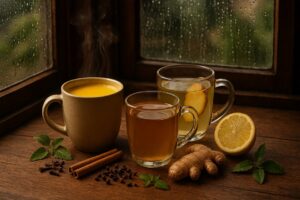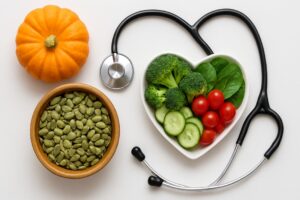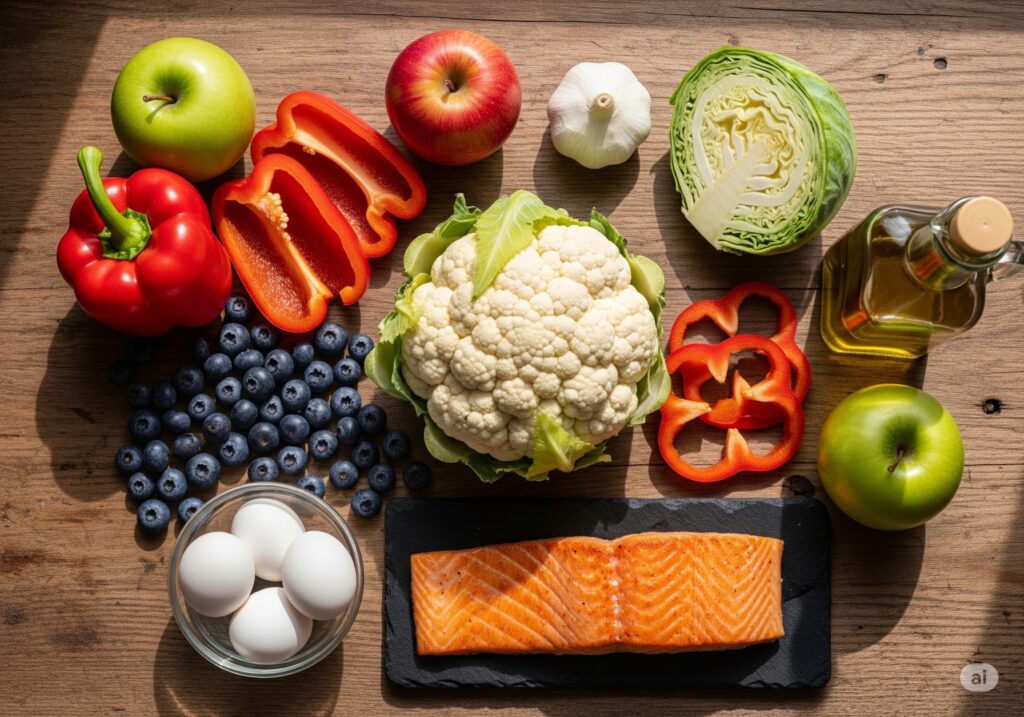
A colorful spread of kidney-friendly foods displayed on a wooden table
Discover the top 9 kidney-friendly foods for CKD. See what to eat, why they help, and smart tips for sodium, potassium, and phosphorus control.
Top 9 Kidney-Friendly Foods for CKD
When your kidneys need extra care, food choices matter a lot. The right foods can support heart health, reduce inflammation, and help manage potassium, sodium, and phosphorus. Yet every person’s needs differ by stage, labs, and dialysis status. So, use this list as a helpful starting point, and always personalize it with a renal dietitian’s guidance. NIDDK+1AJKD
Quick reminder: In chronic kidney disease (CKD), targets for potassium and phosphorus are individualized. This means two people with CKD may get different advice. Therefore, portion size and frequency are key. PMC
1) Cauliflower — A Versatile Star (kidney-friendly foods)
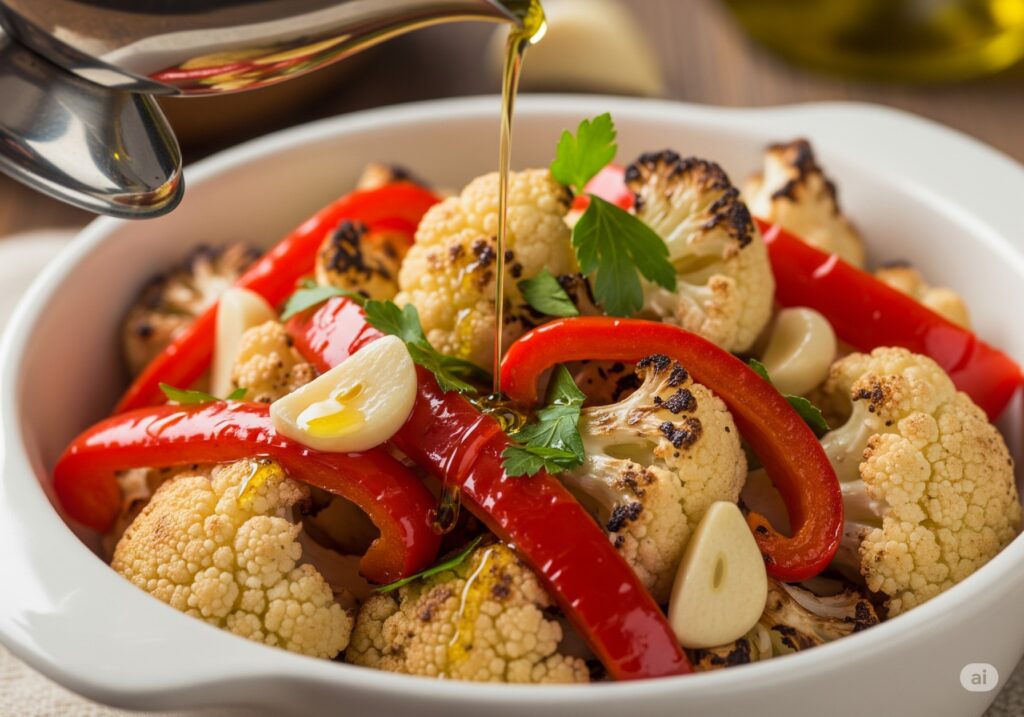
Cauliflower is naturally low in potassium and phosphorus. It is rich in fiber and vitamin C. Use it riced, mashed, or roasted for variety. It also replaces higher-potassium sides like mashed potatoes. Season with herbs instead of salt. National Kidney Foundation, NIDDK
- Try this: Roast florets with garlic and olive oil.
- Why it helps: Supports fiber intake without pushing potassium too high. National Kidney Foundation
2) Red Bell Peppers — Colorful and Light (kidney-friendly foods)
Red bell peppers bring crunch and antioxidants like vitamin C and carotenoids. Better yet, they are relatively low in potassium per serving. Add them to salads, stir-fries, omelets, or dips for fresh flavor. National Kidney Foundation
- Tip: Keep portions moderate. Even lower-potassium foods add up across the day. NIDDK
3) Blueberries and Other Berries — Small but Mighty (kidney-friendly foods)
Strawberries, blueberries, raspberries, blackberries, and cranberries offer polyphenols and fiber. Many are lower in potassium than tropical fruits. Enjoy fresh or frozen. Also, cranberries may support urinary tract health. Still, watch added sugars in juices. National Kidney Foundation
- Serve: Mix into yogurt alternatives or sprinkle on oatmeal made with water. National Kidney Foundation
4) Apples — Easy, Portable, and Flexible (kidney-friendly foods)
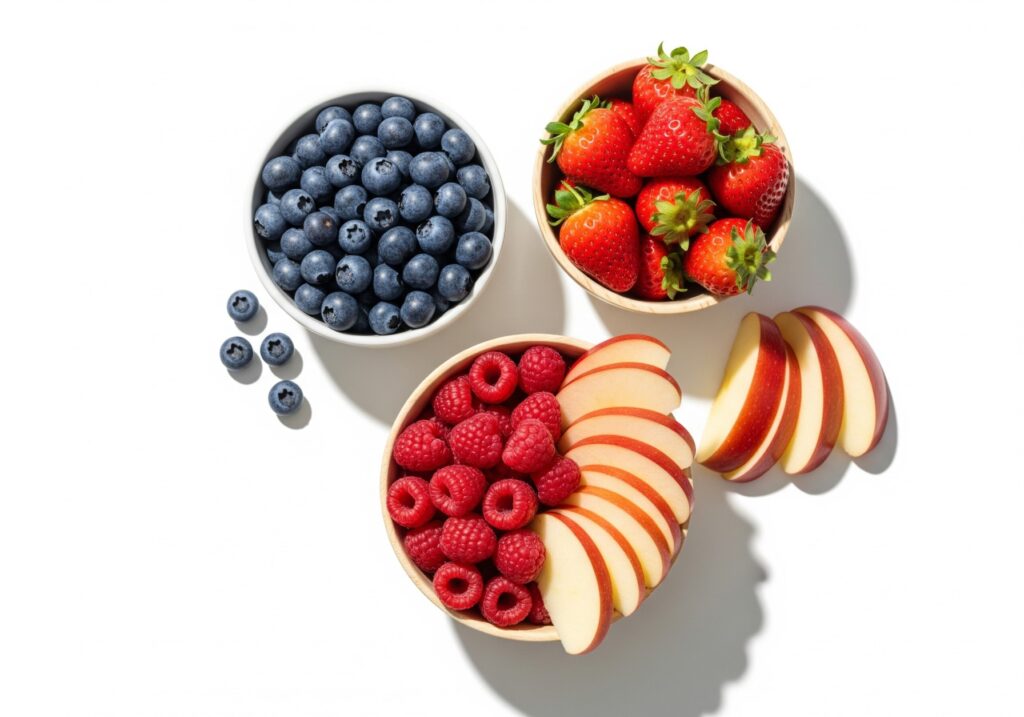
Apples are broadly kidney-friendly in typical portions. They add soluble fiber (pectin) for gut health. Eat them raw, baked with cinnamon, or sliced into salads. As always, portion control is wise. Healthline
- Good to know: Large servings—even of lower-potassium foods—can still raise potassium total for the day. NIDDK
5) Egg Whites — Lean, High-Quality Protein (kidney-friendly foods)
Protein needs vary by CKD stage. Many non-dialysis patients limit protein, while most people on hemodialysis need more high-quality protein. Egg whites provide protein with relatively less phosphorus than whole eggs. Use them in scrambles, muffins, and stir-fries. AJKD, NIDDK
- Portion tip: Work with your renal dietitian to set the grams of protein per day. AJKD
6) Olive Oil — Heart-Healthy Cooking Fat (kidney-friendly foods)
Olive oil supplies monounsaturated fats and plant compounds that support heart health—important because CKD raises cardiovascular risk. It’s naturally free of potassium and phosphorus. Use for roasting, sautéing, and dressings. National Kidney Foundation
- Flavor move: Combine olive oil with garlic, lemon, and herbs to replace salty sauces. NIDDK
7) Garlic — Big Flavor, Less Salt (kidney-friendly foods)
Garlic adds bold taste without sodium. That’s vital because keeping daily sodium low helps manage blood pressure and fluid balance in CKD. Toss minced garlic into roasted vegetables, soups, and marinades. NIDDK
- Why it matters: Using herbs and spices instead of salt or salt substitutes (often high in potassium) is a smart swap. NIDDK
8) Cabbage (and Other Low-Potassium Greens) (kidney-friendly foods)
Green and red cabbage, arugula, and similar leafy greens can fit a kidney-friendly plate in modest portions. They deliver vitamins, fiber, and crunch while keeping potassium manageable. Stir-fry, braise, or shred into slaws. National Kidney Foundation
- Watch out: Kale and spinach are nutritious but can be higher in potassium per cooked serving. Portion size still rules. National Kidney Foundation
9) Fatty Fish (e.g., Salmon) — Omega-3 Support (kidney-friendly foods)
Fish offers omega-3 fats that support heart health and may help with inflammation. However, total protein should align with your stage and treatment plan. Bake, broil, or grill with lemon, pepper, and herbs. Skip heavily salted, smoked, or canned options with added sodium or phosphorus. NIDDK
- Serving guidance: Your dietitian can set fish portions and weekly frequency that match your protein targets. AJKD
Smart Eating Habits for CKD (kidney-friendly foods in daily life)
Control Sodium, But Keep the Flavor (kidney-friendly foods)
Aim for low-sodium choices. Rinse canned veggies and beans. Read labels to avoid potassium chloride in “salt substitute” products. Build flavor with lemon, vinegar, garlic, pepper, and herbs. NIDDK+1
Personalize Potassium and Phosphorus
Targets are not one-size-fits-all. Your care team will set goals based on labs and stage. Use approved food lists, mind portions, and spread produce across meals. PMC
Protein: Not Too Much, Not Too Little
Non-dialysis CKD often means limiting protein to reduce kidney workload. Dialysis often means more protein to maintain muscle and immunity. Check your individualized plan. AJKD, NIDDK
Helpful Links
- NIDDK: Healthy Eating with CKD – guidance on potassium, sodium, and label reading. NIDDK
- NIDDK: Eating & Nutrition for Hemodialysis – protein tips and what to avoid. NIDDK
- KDOQI Nutrition in CKD Guidelines (2020 update) – clinical guidance for professionals, useful to understand why advice differs. AJKD
- National Kidney Foundation: Low-Potassium Produce List – build your grocery list smartly. National Kidney Foundation
Sample One-Day Plate Using These Kidney-Friendly Foods
- Breakfast: Egg-white veggie scramble with red bell peppers and onions. Side of sliced apple.
- Lunch: Cabbage-carrot slaw with olive oil lemon dressing. Grilled chicken or a small portion of salmon (per plan).
- Snack: Blueberries with plain yogurt alternative or a homemade applesauce cup.
- Dinner: Roasted cauliflower with garlic and herbs, plus a modest fish or poultry portion.
- Flavor boosters: Fresh herbs, pepper, lemon, and garlic—no added salt. NIDDK+1
Bottom Line
Focus on low-sodium, thoughtfully portioned, kidney-friendly foods. Choose produce like cauliflower, peppers, berries, apples, and cabbage. Use olive oil and garlic for flavor. Include egg whites and fish as your plan allows. And finally, tailor everything to your labs and stage with a renal dietitian. NIDDK, AJKD
Medical disclaimer
This article is for education only. It does not replace personalized advice from your nephrologist or registered renal dietitian.
